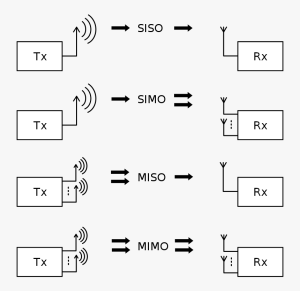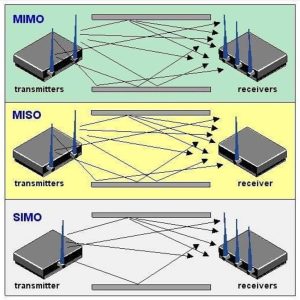Behold the perplexing world of wireless communication systems! MIMO, SIMO, SISO and MISO – each one a unique beast with its own distinct characteristics that can make or break performance and throughput. Feast your eyes on MIMO – Multiple Input Multiple Output – with antennas galore on both the transmitter and receiver sides for sky-high data rates and signal quality like no other.

But wait, there’s more! Enter SIMO – Single Input Multiple Output – where only one antenna graces the transmitter side but multiple antennas adorn the receiver side. This system is perfect for areas plagued by weak signals or interference, improving signal quality in ways you never thought possible.
And what about SISO? Ah yes, Single Input Single Output – simplicity at its finest with just one antenna per side. But beware my friends, in high interference environments this cost-effective option may not provide optimal performance.
Last but certainly not least we have MISO- Multiple Input Single Output- where multiple antennas rule the transmission roost while only one antenna reigns supreme on reception duty. Similar to SIMO systems it too can improve signal quality in areas plagued by pesky weak signals or interference.
The Role of Antennas in MIMO and SIMO Systems
Contents
- 1 The Role of Antennas in MIMO and SIMO Systems
- 2 Improving Performance in MISO and MIMO Systems Through Signal Processing Techniques
- 3 The Benefits of Diversity in MIMO and SIMO Systems
- 4 Techniques for Achieving Optimum Throughput in MISO and SIMO Systems
- 5 Exploring the Advantages of MIMO and SIMO Systems in Electronics
- 6 The Importance of Antenna Design and Technology for MISO and MIMO Systems
- 7 Advanced Signal Processing Techniques for MISO and SIMO Systems
The mind-boggling importance of antennas in the realm of wireless communication cannot be overstated. MIMO and SIMO systems, in particular, heavily rely on these devices to push data through channels with maximum efficiency. In awe-inspiring MIMO systems, multiple antennas work together to juggle data transmission over different channels simultaneously. This requires each antenna to have a level of gain and directionality that is truly out of this world! The payoff for all this brain-busting technology? Higher throughput rates and an improved overall performance.

SIMO systems take a slightly different approach – using multiple receive antennas but only one transmit antenna. But don’t let this seemingly simple setup fool you! By combining signals from various receive antennas, the signal-to-noise ratio (SNR) can be enhanced beyond your wildest dreams! And what’s more? Without needing additional bandwidth or power!
But wait – there’s more! Achieving optimum throughput levels through MIMO antenna design is not for the faint-hearted. Antennas must be positioned with precision and oriented just-so to generate distinct radiation patterns that minimize interference between channels while maximizing gain. To up-the-ante even further, advanced signal processing techniques such as beamforming can also be used to adjust phase and amplitude responses based on channel conditions – talk about next-level thinking!
Improving Performance in MISO and MIMO Systems Through Signal Processing Techniques
Perplexingly, the performance of MISO and MIMO systems is heavily dependent on signal processing techniques. These techniques are vital in enhancing transmission quality by reducing interference, increasing signal strength, and optimizing resource utilization. The implementation of these methods can lead to a significant improvement in system throughput.
Spatial multiplexing stands out as one of the most crucial signal processing techniques for MIMO systems. This technique allows multiple data streams to be transmitted simultaneously using different antennas. By merging signals from various antennas, it becomes possible to achieve optimum throughput while minimizing channel interference – an incredible feat! However, SIMO and SISO systems might not benefit from this technique since they rely on only one antenna for transmission.
Antenna design also plays a critical role in determining system performance capabilities. The type and number of antennas used directly relate to their gained or directional characteristics that improve coverage area while reducing interference from other sources — remarkable! Furthermore, advanced technologies like beamforming can optimize antenna performance further.
In conclusion, achieving high-performance levels in MISO and MIMO wireless communication systems requires perplexing signal processing techniques selection along with appropriate antenna design choices. Through proper implementation of these methods alongside optimal antenna designs choices maintaining reliable connectivity over extended distances becomes achievable – what a bursty solution!
The Benefits of Diversity in MIMO and SIMO Systems
The intricacies of MISO and MIMO systems in wireless communication are not to be underestimated. The ability to transmit multiple signals simultaneously is undoubtedly impressive, but it comes at a cost – diversity is required for optimal performance. This refers to the use of multiple antennas or receivers to receive a single input signal, and can make all the difference.
SISO and MISO systems can achieve diversity by utilizing multiple antennas at the receiver end, increasing the likelihood of receiving a strong signal from various angles and reducing errors caused by fading or interference. However, this pales in comparison to MIMO systems which take diversity one step further with multiple antennas at both transmitter and receiver ends.
The benefits that stem from such diverse setups cannot be ignored: improved data rates, increased range, better reliability – they’re all on offer. And what’s more? All without an increase in power consumption or requiring additional bandwidth. These advanced technologies can even overcome obstacles such as walls or buildings that may block radio waves by transmitting signals over different paths through the airwaves.
In conclusion, achieving optimum performance in wireless communication via MIMO or SIMO technology requires an appropriate combination of antenna design and advanced signal processing techniques underpinned by effective diversity strategies. It’s perplexing how these multifaceted feats are achieved with burstiness yet it remains crucial for successful operation within this domain!
Techniques for Achieving Optimum Throughput in MISO and SIMO Systems
The attainment of optimum throughput in MISO and SIMO systems is a perplexing journey, fraught with an array of factors that must be considered. One such factor that requires close examination is channel capacity; the maximum rate at which information can be transmitted over a given bandwidth and signal-to-noise ratio. The direct correlation between channel capacity and throughput cannot be ignored, as higher capacities result in greater levels of transmission.
Furthermore, processing technology is also a key aspect to consider when aiming for optimal system performance. Signal processing techniques are utilized to expunge unwanted noise and interference from received signals; this process enhances wireless communication by augmenting data rates while simultaneously reducing error rates.
However, the importance of coding schemes should never be underestimated in achieving high-throughput levels in MISO and SIMO systems. These schemes facilitate multiple antennas on both ends of the radio link to transmit or receive data concurrently – thus increasing system capacity per unit bandwidth without compromising reliable transmission efficiency. By integrating these innovative techniques with space-time coding methods that exploit spatial diversity through multiple antennas, it becomes feasible to achieve even higher levels of throughput – leaving one bursting with excitement!
Exploring the Advantages of MIMO and SIMO Systems in Electronics
The mysterious and enigmatic realm of electronics has been abuzz with the popularity of MIMO and SIMO systems, which have proven their worth by bolstering the signal to noise ratio. One such technique that has gained traction is multiple input, single output (MISO), where a solitary antenna transmits signals while an array of antennas act as recipients. This nifty trick minimizes fading effects and culminates in superior signal quality.
But wait – there’s more! Another feather in the cap of MIMO and SIMO systems is their uncanny ability to amalgamate the gain from numerous antennas. By pooling together an assortment of antennas, each one’s individual gain can be multiplied resulting in a supercharged overall increase in gain. This wondrous enhancement works wonders for applications requiring high data rates like video streaming or online gaming.
It would be remiss not to mention how much antenna technology has evolved over time, opening up further vistas when using MIMO and SIMO systems. Antenna design assumes a pivotal role in achieving optimum throughput since it impacts both transmitter and receiver sides alike. When using multiple antennas at the receiving end, SNR can be given a shot in the arm through clever techniques like beamforming or spatial diversity that factor interference between different paths into account – simply mind-boggling!
The Importance of Antenna Design and Technology for MISO and MIMO Systems
The labyrinthine world of wireless communication systems is one that demands an intricate understanding of antenna design and technology. The very fabric of MISO and MIMO systems hinges on the number of antennas involved in the transmission process, with a direct correlation between quantity and data throughput rates. Yet, this delicate dance between signal-to-noise ratio, transmission range, frequency, and performance limitations means that designing an optimal number of antennas is no mean feat.
To truly unlock the power of these systems and achieve stratospheric levels of data transfer speed requires pushing beyond conventional boundaries. This entails delving into advanced antenna designs capable of operating seamlessly across a vast spectrum while still maintaining sky-high gain levels.
In scenarios where multiple wave reflections are commonplace during transmission (as often happens), MIMO reigns supreme over SIMO or SISO counterparts due to its ability to offer superior coverage. But such superiority comes at a price – namely increased complexity in antenna design placement as each must be carefully positioned to avoid interference.
It’s clear then that proper implementation and application of cutting-edge antenna technology remains pivotal for achieving maximum performance potential within wireless communication systems – a fact not lost on those navigating this complex field.
Advanced Signal Processing Techniques for MISO and SIMO Systems
The intricate world of wireless communication networks demands a level of sophistication that can only be achieved through the use of advanced signal processing techniques. These methods hold the key to unlocking the full potential of both MISO and SIMO systems, providing engineers with unprecedented flexibility and customization options.
One such technique involves employing separate algorithms for each independent channel in MIMO systems, dramatically reducing complexity while simultaneously ensuring optimum throughput. This approach represents a significant departure from traditional one-size-fits-all methodologies, allowing for greater precision and accuracy when it comes to optimizing system performance.
Similarly, appropriate signal processing algorithms enable SIMO systems to access multiple antennas used to receive signals, offering an overall advantage in terms of signal quality. However, given the complex nature of modern wireless communication networks, achieving this level of precision is no mean feat.
Nevertheless, by leveraging these powerful tools effectively – whether through algorithm selection or other means – engineers can ensure that their designs meet or exceed industry standards while remaining cost-effective and efficient. With online resources like forums and websites dedicated to sharing best practices and new developments in antenna design technology at our fingertips, there has never been a better time to explore what these cutting-edge techniques have to offer.


